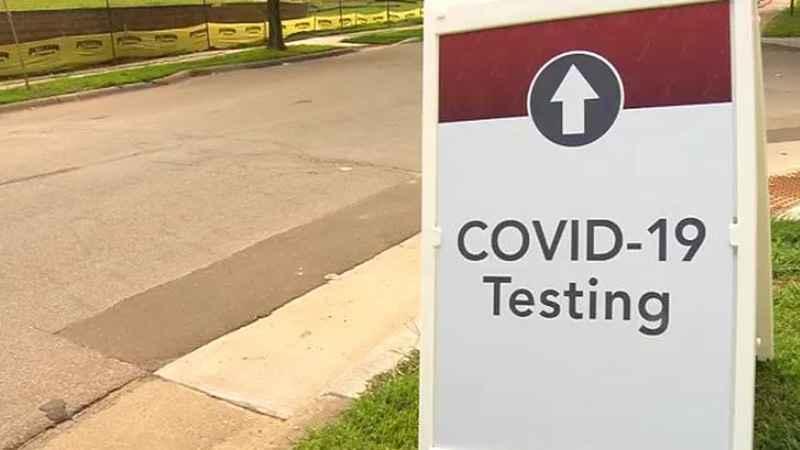MDH COVID-19 briefing: Minnesota updates testing guidelines, includes students, young athletes
[anvplayer video=”5000876″ station=”998122″]
During the state’s regular COVID-19 briefing on Thursday, Minnesota health officials discussed changes to how the state investigates COVID-19 cases, as well as updates to testing guidance.
The typical case investigation involves public health workers contacting people by phone. Now when someone tests positive, the Minnesota Department of Health will send a text message inviting that person to participate in a survey.
“Tools like this case investigation survey mean we can reach more people, more quickly and ideally slow the spread of COVID-19 in the state,” Minnesota Department of Health Director of Infectious Disease Epidemiology Kris Ehresmann said.
Both the text and survey will be offered in multiple languages, according to Ehresmann.

[KSTP-TV]
Anyone who would rather talk to a contact tracer on the phone can ignore the text and wait for a call, Ehresmann added.
KSTP’s latest COVID-19 coverage
“The benefits for Minnesotans who test positive is that they don’t have to wait for a call but can just jump right in and learn more about how to keep themselves and their family safe,” she said.
Ehresmann did say that moving to a system using texting and calling can attract scam artists. She said red flags to watch for include requests for money or financial information. Anyone with concerns is asked to call MDH at 651-201-4989.
The health officials also took time to discuss new testing guidelines that have been put in place after Gov. Tim Walz loosened regulations on in-person learning and extracurricular activities.
“Even as we continue to focus on moving ahead with vaccinations we know that demand significantly outpaces supply coming to states from the federal government,” MDH Assistant Commissioner Dan Huff said. “As a result, testing remains a critical tool in our effort to stop the spread of this virus.”
The new guidance recommends testing for any student returning to in-person learning, youth sports or extracurricular activities, as well college or trade students returning to classes. The guidance also recommends anyone who regularly interacts with people outside of their family unit or household be tested.
Huff told 5 EYEWITNESS NEWS the decision by Gov. Walz to ease many restrictions will increase social interactions and the chance for spread.
“Schools are opening up, kids are going back to college, sports are going so that’s just a lot of social interaction among people from different households,” said Huff.
The new guidelines specifically recommend people between the ages of 12 and 25 receive testing, however, Huff said MDH encourages anyone returning to the classroom to get tested, even those younger than 12.
MDH already recommends testing for anyone who has symptoms and people working in settings such as critical infrastructure, first responders, health care, retail, schools, child care and others who interact with people outside their household.
Huff reiterated that testing is available to all Minnesotans who need one.
He suggests parents order a saliva testing kit or take their child to a testing site about every two to four weeks.
“Most of our young children infected may be asymptomatic, or maybe you think they have a cold or a runny nose,” Huff said. “Getting tested is a good idea because that helps limit spread to other people.”
KSTP Medical Expert Dr. Archelle Georgiou said testing, tracing and isolation are essential to stopping the spread until more vaccines are administered.
“To me, it makes so much sense they would encourage this younger population to get tested,” she said. “They’re out and about, many are back in school, back in sports and this is also the population that is the least likely to have symptoms from COVID but still be infectious.”
MDH has also been providing schools free tests for teachers and staff to take every other week. It is a voluntary test but schools are required to provide them.
“Fifty percent of COVID infections come from people that didn’t even know they had it,” Huff said. “We want schools to be successful, we want sports to be successful and one way to do that is to make sure that we end asymptomatic spread. The only way to do that is get tested.”
Since that program began earlier this month, more than 17,000 staff have been tested. MDH said there’s been a 0.36% positivity rate.
“We are entering a really dark phase of this pandemic,” Dr. Georgiou said. “We think that March is going to be a challenging month so anything we can do now to identify who has the virus, how we can keep them from infecting others is the most important thing we can do right now.”
She said the UK variant, which is more transmissible, is projected to be the dominant strain in the U.S. by March.
Huff also reminded Minnesotans of the importance of continuing to wear masks, practicing social distancing and following other COVID-19 guidelines.
[anvplayer video=”5000670″ station=”998122″]